-
 Daniel H. Wells
Daniel H. Wells
-
 An Act in Relation to Unlawful Assembling of Indians
An Act in Relation to Unlawful Assembling of Indians
-
 Orson Spencer
Orson Spencer
-
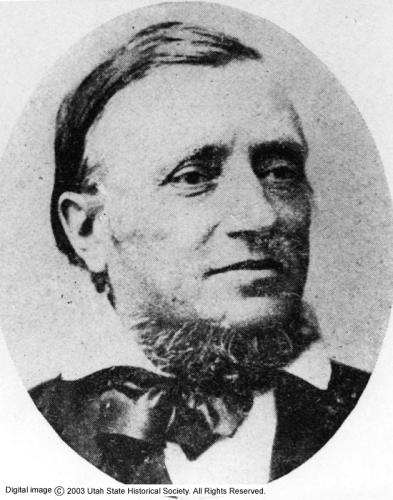 Thomas H. Bullock, pioneer
Thomas H. Bullock, pioneer
-
 Preliminary Map of Routes Reconnoitered and Opened in the Territory of Utah
Preliminary Map of Routes Reconnoitered and Opened in the Territory of Utah
-
 An Act to secure freedom to all persons within the Territories of the United States
An Act to secure freedom to all persons within the Territories of the United States
-
 “To the Saints,” Deseret News, April 3, 1852, 2.
“To the Saints,” Deseret News, April 3, 1852, 2. Willard Richards, counselor to Brigham Young in the Latter-day Saint First Presidency, offers his own interpretation of the Latter-day Saint priesthood restriction within two months of Young's strident speech to the legislature. Richards draws on some of Young's ideas, but adds his own unique explanation as well. He draws on the Tower of Babel story to justify the racial restriction. “To the Saints,” Deseret News, April 3, 1852, 2. [Willard Richards, Editor]
-
 Schedule of Property of David Lewis, Deceased
Schedule of Property of David Lewis, Deceased Schedule of Property of David Lewis, deceased, Utah Territory, Probate Court Records, Salt Lake County, Series 1621, Reel 1, Box 1, Folder 41, Utah Division of Archives and Records Service, Salt Lake City, Utah.
-
 Working draft of An Act in Relation to Service
Working draft of An Act in Relation to Service Working draft of An Act in Relation to Service. Section 3 includes eighteen words (and his, her, or their children, until the curse of servitude is taken from the descendants of Canaan) crossed out. Those words were removed before final passage of the bill, likely in response to Orson Pratt's speech in opposition to the bill.
-
 Orson Pratt (1811 - 1881)
Orson Pratt (1811 - 1881) Orson Pratt (1811-1881) was born in Hartford, New York. His older brother Parley P. Pratt baptized him into the Church of Christ (later renamed the Church of Jesus Christ of Latter-day Saints) in 1830, its founding year. He was an original member of the Quorum of Twelve Apostles. In 1852, he served as a member of the territorial legislative Council from Salt Lake County. He and Edward Hunter were elected in November 1851 to replace Ezra T. Benson and Jedediah M. Grant following their resignations. Pratt is perhaps best known for his theological studies and defenses of Latter-day Saint doctrines which he produced in pamphlet form primarily for missionary purposes. Courtesy Church History Library, Church of Jesus Christ of Latter-day Saints, Salt Lake City, Utah.
-
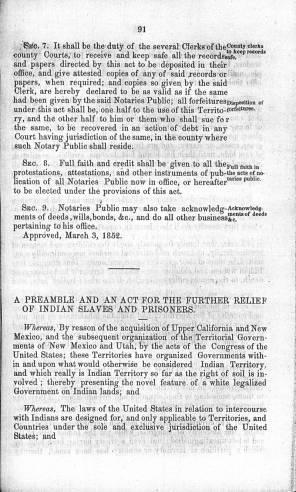 A Preamble and An Act for the Relief of Indian Slaves and Prisoners
A Preamble and An Act for the Relief of Indian Slaves and Prisoners A Preamble and An Act for the Relief of Indian Slaves and Prisoners in Acts, Resolutions, and Memorials, Passed by the First Annual, and Special Sessions of the Legislative Assembly of the Territory of Utah, Begun and Held at Great Salt Lake City, on the 22nd Day of September, A. D. 1851 (Salt Lake City: Brigham H. Young, Printer, 1852), 91-94
-
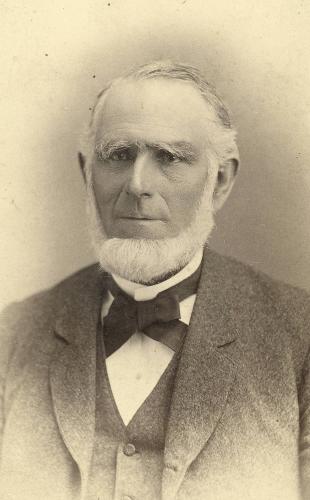 Abraham Owen Smoot (1815 - 1895)
Abraham Owen Smoot (1815 - 1895) Abraham Owen Smoot (1815 - 1895) and his wife Margaret Thompson McMeans (1809 - 1884) sold an enslaved woman named Lucinda to Thomas S. Williams for $400.00 in Utah Territory, March 1, 1852. Public Domain.
-
 Edwin D. Woolley (1807-1881)
Edwin D. Woolley (1807-1881) Edwin D. Woolley (1807-1881) was a convert from Quakerism born in West Chester, Pennsylvania. He was a member of the House of Representatives from Salt Lake County. He later served as bishop of the Salt Lake City 13th Ward. Public domain.
-
 John Greiner, Santa Fe, New Mexico, to Luke Lea, Washington D.C., 19 May 1852
John Greiner, Santa Fe, New Mexico, to Luke Lea, Washington D.C., 19 May 1852 John Greiner, Santa Fe, New Mexico, to Luke Lea, Washington D.C., 19 May 1852, in Official Correspondence of James S. Calhoun while Indian Agent at Santa Fe and Superintendent of Indian Affairs in New Mexico, ed. Annie Heloise Abel (Washington, D.C.: Government Printing Office, 1915), 536-537.
-
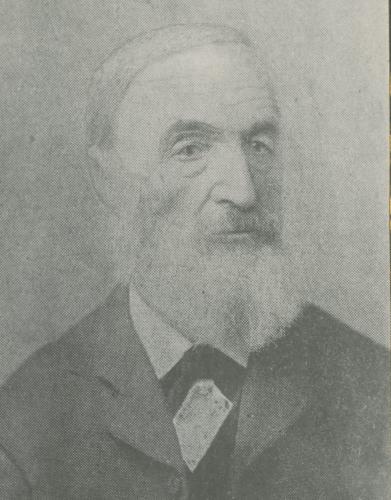 Associate Justice Zerubbabel Snow (1809-1888)
Associate Justice Zerubbabel Snow (1809-1888) Associate Justice Zerubbabel Snow (1809-1888) presided over Don Pedro León Luján's two trials in Salt Lake City. He was a federally appointed judge and a Latter-day Saint. Courtesy Church History Library, Church of Jesus Christ of Latter-day Saints, Salt Lake City, Utah.
-
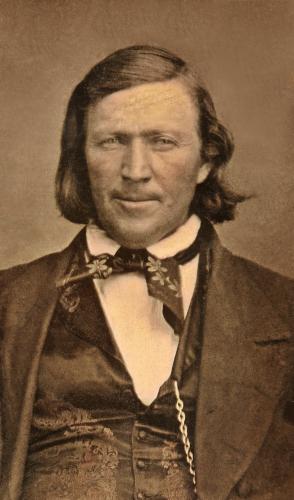 Brigham Young (1801-1877)
Brigham Young (1801-1877) Brigham Young (1801-1877) was a key witness in the trial of Don Pedro León Luján and governor of Utah Territory in 1852. He was also president of the Church of Jesus Christ of Latter-day Saints and considered to be a prophet by the Latter-day Saint faithful. This photograph was likely taken by Marsena Cannon around 1850. Courtesy Church History Library. Church of Jesus Christ of Latter-day Saints, Salt Lake City, Utah.
-
 Brigham Young's Opening Speech to the Territorial Legislature, January 5, 1852.
Brigham Young's Opening Speech to the Territorial Legislature, January 5, 1852. Brigham Young opened the legislative session on January 5, 1852, with a prepared speech which his secretary Thomas Bullock read to a joint session of the legislature. The speech was subsequently published in the legislative journal and in the Deseret News, the version featured here. “Governor’s Message,” Deseret News, 10 January 1852, 18.
-
 United States vs Pedro Leon and Others
United States vs Pedro Leon and Others Joshua Slayton, attorney for the Indians held in custody, argued that they should not be considered “confiscated property, January 12, 1852. First District Court Case Files, Series 25011, Reel 1, Box 10, Folder 12, 307, Utah Division of Archives and Records Services, Salt Lake City, Utah.
-
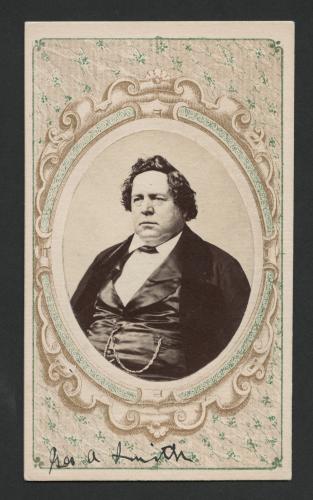 George A. Smith (1817-1875)
George A. Smith (1817-1875) George A. Smith (1817-1875) served as Don Pedro León Luján's defense attorney at the trial. He was also an apostle in the Church of Jesus Christ of Latter-day Saints and a member of the territorial legislature in 1852. Courtesy Church History Library.
-
 Council House
Council House
-
 U.S. House of Representatives Bill, outlawing slavery and involuntary servitude in all U.S. territories
U.S. House of Representatives Bill, outlawing slavery and involuntary servitude in all U.S. territories The United States Congress outlaws slavery and involuntary servitude in all U.S. territories, June 20, 1862.
-
 Excerpt from New York Herald, Horace Greeley interviews Brigham Young on slavery
Excerpt from New York Herald, Horace Greeley interviews Brigham Young on slavery New York Herald editor Horace Greeley interviews Brigham Young in 1859 regarding his views on slavery.
-
 Edwin D. Woolley Affidavit
Edwin D. Woolley Affidavit Edwin D. Woolley's original sworn complaint in the Dan Camp case.
-
 Delegates to the 1856 Utah Constitutional Convention debate whether Utah will apply as a slave or free state. Orson Pratt delivers an anti-slavery speech, March 22, 1856.
Delegates to the 1856 Utah Constitutional Convention debate whether Utah will apply as a slave or free state. Orson Pratt delivers an anti-slavery speech, March 22, 1856. Delegates to the 1856 Utah Constitutional Convention debate whether Utah will apply as a slave or free state
-
 Estate Settlement of David Lewis, including two "Indian boys" and an effort to sell an enslaved man named Jerry
Estate Settlement of David Lewis, including two "Indian boys" and an effort to sell an enslaved man named Jerry The settlement of the estate of David Lewis which included three enslaved people and two "Indian boys" and his widow Duritha Trail Lewis's effort to sale an enslaved man named Jerry and Brigham Young's response.
 Daniel H. Wells
Daniel H. Wells
 An Act in Relation to Unlawful Assembling of Indians
An Act in Relation to Unlawful Assembling of Indians
 Orson Spencer
Orson Spencer
 Thomas H. Bullock, pioneer
Thomas H. Bullock, pioneer
 Preliminary Map of Routes Reconnoitered and Opened in the Territory of Utah
Preliminary Map of Routes Reconnoitered and Opened in the Territory of Utah
 An Act to secure freedom to all persons within the Territories of the United States
An Act to secure freedom to all persons within the Territories of the United States
 “To the Saints,” Deseret News, April 3, 1852, 2. Willard Richards, counselor to Brigham Young in the Latter-day Saint First Presidency, offers his own interpretation of the Latter-day Saint priesthood restriction within two months of Young's strident speech to the legislature. Richards draws on some of Young's ideas, but adds his own unique explanation as well. He draws on the Tower of Babel story to justify the racial restriction. “To the Saints,” Deseret News, April 3, 1852, 2. [Willard Richards, Editor]
“To the Saints,” Deseret News, April 3, 1852, 2. Willard Richards, counselor to Brigham Young in the Latter-day Saint First Presidency, offers his own interpretation of the Latter-day Saint priesthood restriction within two months of Young's strident speech to the legislature. Richards draws on some of Young's ideas, but adds his own unique explanation as well. He draws on the Tower of Babel story to justify the racial restriction. “To the Saints,” Deseret News, April 3, 1852, 2. [Willard Richards, Editor] Schedule of Property of David Lewis, Deceased Schedule of Property of David Lewis, deceased, Utah Territory, Probate Court Records, Salt Lake County, Series 1621, Reel 1, Box 1, Folder 41, Utah Division of Archives and Records Service, Salt Lake City, Utah.
Schedule of Property of David Lewis, Deceased Schedule of Property of David Lewis, deceased, Utah Territory, Probate Court Records, Salt Lake County, Series 1621, Reel 1, Box 1, Folder 41, Utah Division of Archives and Records Service, Salt Lake City, Utah. Working draft of An Act in Relation to Service Working draft of An Act in Relation to Service. Section 3 includes eighteen words (and his, her, or their children, until the curse of servitude is taken from the descendants of Canaan) crossed out. Those words were removed before final passage of the bill, likely in response to Orson Pratt's speech in opposition to the bill.
Working draft of An Act in Relation to Service Working draft of An Act in Relation to Service. Section 3 includes eighteen words (and his, her, or their children, until the curse of servitude is taken from the descendants of Canaan) crossed out. Those words were removed before final passage of the bill, likely in response to Orson Pratt's speech in opposition to the bill. Orson Pratt (1811 - 1881) Orson Pratt (1811-1881) was born in Hartford, New York. His older brother Parley P. Pratt baptized him into the Church of Christ (later renamed the Church of Jesus Christ of Latter-day Saints) in 1830, its founding year. He was an original member of the Quorum of Twelve Apostles. In 1852, he served as a member of the territorial legislative Council from Salt Lake County. He and Edward Hunter were elected in November 1851 to replace Ezra T. Benson and Jedediah M. Grant following their resignations. Pratt is perhaps best known for his theological studies and defenses of Latter-day Saint doctrines which he produced in pamphlet form primarily for missionary purposes. Courtesy Church History Library, Church of Jesus Christ of Latter-day Saints, Salt Lake City, Utah.
Orson Pratt (1811 - 1881) Orson Pratt (1811-1881) was born in Hartford, New York. His older brother Parley P. Pratt baptized him into the Church of Christ (later renamed the Church of Jesus Christ of Latter-day Saints) in 1830, its founding year. He was an original member of the Quorum of Twelve Apostles. In 1852, he served as a member of the territorial legislative Council from Salt Lake County. He and Edward Hunter were elected in November 1851 to replace Ezra T. Benson and Jedediah M. Grant following their resignations. Pratt is perhaps best known for his theological studies and defenses of Latter-day Saint doctrines which he produced in pamphlet form primarily for missionary purposes. Courtesy Church History Library, Church of Jesus Christ of Latter-day Saints, Salt Lake City, Utah. A Preamble and An Act for the Relief of Indian Slaves and Prisoners A Preamble and An Act for the Relief of Indian Slaves and Prisoners in Acts, Resolutions, and Memorials, Passed by the First Annual, and Special Sessions of the Legislative Assembly of the Territory of Utah, Begun and Held at Great Salt Lake City, on the 22nd Day of September, A. D. 1851 (Salt Lake City: Brigham H. Young, Printer, 1852), 91-94
A Preamble and An Act for the Relief of Indian Slaves and Prisoners A Preamble and An Act for the Relief of Indian Slaves and Prisoners in Acts, Resolutions, and Memorials, Passed by the First Annual, and Special Sessions of the Legislative Assembly of the Territory of Utah, Begun and Held at Great Salt Lake City, on the 22nd Day of September, A. D. 1851 (Salt Lake City: Brigham H. Young, Printer, 1852), 91-94 Abraham Owen Smoot (1815 - 1895) Abraham Owen Smoot (1815 - 1895) and his wife Margaret Thompson McMeans (1809 - 1884) sold an enslaved woman named Lucinda to Thomas S. Williams for $400.00 in Utah Territory, March 1, 1852. Public Domain.
Abraham Owen Smoot (1815 - 1895) Abraham Owen Smoot (1815 - 1895) and his wife Margaret Thompson McMeans (1809 - 1884) sold an enslaved woman named Lucinda to Thomas S. Williams for $400.00 in Utah Territory, March 1, 1852. Public Domain. Edwin D. Woolley (1807-1881) Edwin D. Woolley (1807-1881) was a convert from Quakerism born in West Chester, Pennsylvania. He was a member of the House of Representatives from Salt Lake County. He later served as bishop of the Salt Lake City 13th Ward. Public domain.
Edwin D. Woolley (1807-1881) Edwin D. Woolley (1807-1881) was a convert from Quakerism born in West Chester, Pennsylvania. He was a member of the House of Representatives from Salt Lake County. He later served as bishop of the Salt Lake City 13th Ward. Public domain. John Greiner, Santa Fe, New Mexico, to Luke Lea, Washington D.C., 19 May 1852 John Greiner, Santa Fe, New Mexico, to Luke Lea, Washington D.C., 19 May 1852, in Official Correspondence of James S. Calhoun while Indian Agent at Santa Fe and Superintendent of Indian Affairs in New Mexico, ed. Annie Heloise Abel (Washington, D.C.: Government Printing Office, 1915), 536-537.
John Greiner, Santa Fe, New Mexico, to Luke Lea, Washington D.C., 19 May 1852 John Greiner, Santa Fe, New Mexico, to Luke Lea, Washington D.C., 19 May 1852, in Official Correspondence of James S. Calhoun while Indian Agent at Santa Fe and Superintendent of Indian Affairs in New Mexico, ed. Annie Heloise Abel (Washington, D.C.: Government Printing Office, 1915), 536-537. Associate Justice Zerubbabel Snow (1809-1888) Associate Justice Zerubbabel Snow (1809-1888) presided over Don Pedro León Luján's two trials in Salt Lake City. He was a federally appointed judge and a Latter-day Saint. Courtesy Church History Library, Church of Jesus Christ of Latter-day Saints, Salt Lake City, Utah.
Associate Justice Zerubbabel Snow (1809-1888) Associate Justice Zerubbabel Snow (1809-1888) presided over Don Pedro León Luján's two trials in Salt Lake City. He was a federally appointed judge and a Latter-day Saint. Courtesy Church History Library, Church of Jesus Christ of Latter-day Saints, Salt Lake City, Utah. Brigham Young (1801-1877) Brigham Young (1801-1877) was a key witness in the trial of Don Pedro León Luján and governor of Utah Territory in 1852. He was also president of the Church of Jesus Christ of Latter-day Saints and considered to be a prophet by the Latter-day Saint faithful. This photograph was likely taken by Marsena Cannon around 1850. Courtesy Church History Library. Church of Jesus Christ of Latter-day Saints, Salt Lake City, Utah.
Brigham Young (1801-1877) Brigham Young (1801-1877) was a key witness in the trial of Don Pedro León Luján and governor of Utah Territory in 1852. He was also president of the Church of Jesus Christ of Latter-day Saints and considered to be a prophet by the Latter-day Saint faithful. This photograph was likely taken by Marsena Cannon around 1850. Courtesy Church History Library. Church of Jesus Christ of Latter-day Saints, Salt Lake City, Utah. Brigham Young's Opening Speech to the Territorial Legislature, January 5, 1852. Brigham Young opened the legislative session on January 5, 1852, with a prepared speech which his secretary Thomas Bullock read to a joint session of the legislature. The speech was subsequently published in the legislative journal and in the Deseret News, the version featured here. “Governor’s Message,” Deseret News, 10 January 1852, 18.
Brigham Young's Opening Speech to the Territorial Legislature, January 5, 1852. Brigham Young opened the legislative session on January 5, 1852, with a prepared speech which his secretary Thomas Bullock read to a joint session of the legislature. The speech was subsequently published in the legislative journal and in the Deseret News, the version featured here. “Governor’s Message,” Deseret News, 10 January 1852, 18. United States vs Pedro Leon and Others Joshua Slayton, attorney for the Indians held in custody, argued that they should not be considered “confiscated property, January 12, 1852. First District Court Case Files, Series 25011, Reel 1, Box 10, Folder 12, 307, Utah Division of Archives and Records Services, Salt Lake City, Utah.
United States vs Pedro Leon and Others Joshua Slayton, attorney for the Indians held in custody, argued that they should not be considered “confiscated property, January 12, 1852. First District Court Case Files, Series 25011, Reel 1, Box 10, Folder 12, 307, Utah Division of Archives and Records Services, Salt Lake City, Utah. George A. Smith (1817-1875) George A. Smith (1817-1875) served as Don Pedro León Luján's defense attorney at the trial. He was also an apostle in the Church of Jesus Christ of Latter-day Saints and a member of the territorial legislature in 1852. Courtesy Church History Library.
George A. Smith (1817-1875) George A. Smith (1817-1875) served as Don Pedro León Luján's defense attorney at the trial. He was also an apostle in the Church of Jesus Christ of Latter-day Saints and a member of the territorial legislature in 1852. Courtesy Church History Library. Council House
Council House
 U.S. House of Representatives Bill, outlawing slavery and involuntary servitude in all U.S. territories The United States Congress outlaws slavery and involuntary servitude in all U.S. territories, June 20, 1862.
U.S. House of Representatives Bill, outlawing slavery and involuntary servitude in all U.S. territories The United States Congress outlaws slavery and involuntary servitude in all U.S. territories, June 20, 1862. Excerpt from New York Herald, Horace Greeley interviews Brigham Young on slavery New York Herald editor Horace Greeley interviews Brigham Young in 1859 regarding his views on slavery.
Excerpt from New York Herald, Horace Greeley interviews Brigham Young on slavery New York Herald editor Horace Greeley interviews Brigham Young in 1859 regarding his views on slavery. Edwin D. Woolley Affidavit Edwin D. Woolley's original sworn complaint in the Dan Camp case.
Edwin D. Woolley Affidavit Edwin D. Woolley's original sworn complaint in the Dan Camp case. Delegates to the 1856 Utah Constitutional Convention debate whether Utah will apply as a slave or free state. Orson Pratt delivers an anti-slavery speech, March 22, 1856. Delegates to the 1856 Utah Constitutional Convention debate whether Utah will apply as a slave or free state
Delegates to the 1856 Utah Constitutional Convention debate whether Utah will apply as a slave or free state. Orson Pratt delivers an anti-slavery speech, March 22, 1856. Delegates to the 1856 Utah Constitutional Convention debate whether Utah will apply as a slave or free state Estate Settlement of David Lewis, including two "Indian boys" and an effort to sell an enslaved man named Jerry The settlement of the estate of David Lewis which included three enslaved people and two "Indian boys" and his widow Duritha Trail Lewis's effort to sale an enslaved man named Jerry and Brigham Young's response.
Estate Settlement of David Lewis, including two "Indian boys" and an effort to sell an enslaved man named Jerry The settlement of the estate of David Lewis which included three enslaved people and two "Indian boys" and his widow Duritha Trail Lewis's effort to sale an enslaved man named Jerry and Brigham Young's response.